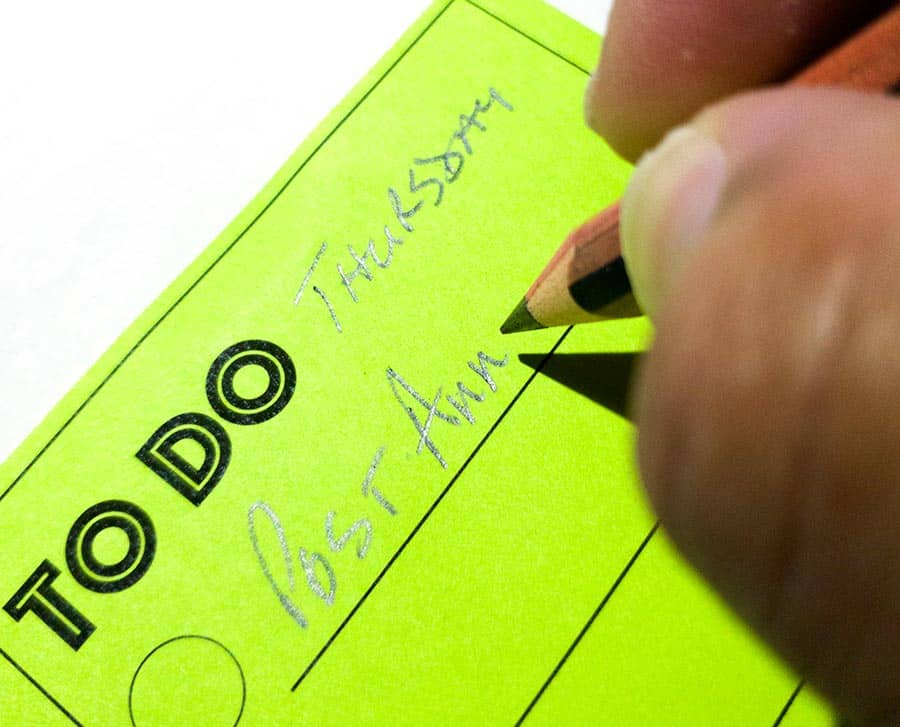
Above: My personal organisation begins with a prioritised list. Photo by Mark Lyndersay.
BitDepth#1234 for January 30, 2020
Right about now you’re probably trying to remember what your New Year’s resolution was. You’re probably not alone.
Here’s a resolution to rule them all.
Write it down. Write all of it down. Every day.
It really is as simple as that.
Very few people can juggle more than a few simultaneous thoughts, and every stray thought drags focus from another.
Many decades ago, when reading an early edition of Peter Drucker’s The Effective Executive, and wearing a tie and hard shoes made up a significant part of my day; the standout revelation to me was his advice to make a list of things that needed to be done.
David Allen codified the listing technique in his book Getting Things Done more recently, spawning the GTD technique and business empire.
At the core of the GTD approach was the notion that making lists as a way to concentrate more effectively on the task at hand. In that system, organised lists are a holding tray for future action.
What Drucker proposed was an ordering of intent, Allen expanded that into a system, dividing projects into discrete tasks and building out methodologies for holding, reviewing and doing these action steps more effectively.
I’ve always been available for these pitches. Moreso when they come with their own nifty hardware and today, software, to provide a clear framework for success.
I’ve immersed myself in an awful lot of them. I still own a DayRunner diary from the era when that modular system thrived and encouraged you to buy all kinds of cool stationery items to clip into it.
The GTD system is impressive, but demands a level of commitment I could not muster.
Rewriting tasks to a refreshed priority refocuses the importance of looming deadlines…
I really liked the Kanban System and the Eisenhower Quadrant, both of which appealed to my visual sense.
In the Kanban system, you create three lists, to-do, doing and done and write your lists as a series of Post-It notes, moving them from one stage to the next.
Unfortunately the fan running in my office paid to that concept, blowing notes everywhere.
The Eisenhower system divides a page into four quadrants: do now, important, delegate and long-term actions.
Like GTD, the quadrant turned out to be an awful lot of work with little discernible advantage.
I’ve tried many apps that implement popular systems of list management, and I’ve settled into a mix of hard copy and app support.
Today I use Things, one of many apps that implements the GTD system in an accessible way to store and organise notions and ideas.
From time to time, I’ll crack it open, delete some things, enhance or expand some other things and sometimes stare at some lunatic notion and wonder how it ended up there.
For day to day work, I align clearing up the inevitable clutter of my desk with a revisiting of the previous day’s list, which I will rewrite with new priorities (Printable PDFs of my list templates are here).
It is this final act that I find most motivating.
Being able to cross an item off the list and not have to rewrite it will, sometimes, move me to do something I might otherwise leave undone in a fit of righteous laziness.
Rewriting tasks to a refreshed priority refocuses the importance of looming deadlines or worse, the prospect of having to explain to someone why I’m not ready yet.
Somehow saying “you’re on the list” doesn’t seem to have the same calming effect on clients that it does on me.
List making is ultimately a very personal experience and that’s why so many techniques and systems have co-existed for so long.
The key is to make a start, to get your tasks out of your head and organise them for action.



